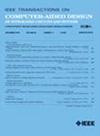Efficient Cartesian Genetic Programming-Based Automatic Synthesis Framework for Reversible Quantum-Flux-Parametron Logic Circuits
IF 2.9
3区 计算机科学
Q2 COMPUTER SCIENCE, HARDWARE & ARCHITECTURE
IEEE Transactions on Computer-Aided Design of Integrated Circuits and Systems
Pub Date : 2025-02-27
DOI:10.1109/TCAD.2025.3546884
引用次数: 0
Abstract
Reversible computing has garnered significant attention as a promising avenue for achieving energy-efficient computing systems, particularly within the realm of quantum computing. The reversible quantum-flux-parametron (RQFP) is the first practical reversible logic gate utilizing adiabatic superconducting devices, with experimental evidence supporting both its logical and physical reversibility. Each RQFP logic gate operates on alternating current (AC) power and features three input ports and three output ports. Notably, each output port is capable of implementing a majority function while driving only a single fan-out. Additionally, the three inputs to each gate must arrive in the same clock phase. These inherent characteristics present substantial challenges in the design of RQFP logic circuits. To address these challenges, this article proposes an automatic synthesis framework for RQFP logic circuit design based on efficient Cartesian genetic programming (CGP). The framework aims to minimize both the number of RQFP logic gates and the number of garbage outputs within the generated RQFP logic circuit. It incorporates the specific characteristics of the RQFP logic circuit by encoding them into the genotype of a CGP individual. It also introduces several point mutation operations to facilitate the generation of new individuals. Furthermore, the framework integrates circuit simulation with formal verification to assess the functional equivalence between the parent and its offspring. Experimental results on RevLib and reversible reciprocal circuit benchmarks demonstrate the effectiveness of our framework.基于高效笛卡尔遗传规划的可逆量子通量参数逻辑电路自动综合框架
可逆计算作为实现节能计算系统的有前途的途径,特别是在量子计算领域,已经引起了极大的关注。可逆量子通量参数管(RQFP)是第一个实用的利用绝热超导器件的可逆逻辑门,具有实验证据支持其逻辑和物理可逆性。每个RQFP逻辑门在交流(AC)电源上工作,具有三个输入端口和三个输出端口。值得注意的是,每个输出端口都能够在仅驱动单个扇出时实现多数功能。此外,每个门的三个输入必须到达相同的时钟相位。这些固有的特性给RQFP逻辑电路的设计带来了巨大的挑战。为了解决这些问题,本文提出了一种基于高效笛卡尔遗传规划(CGP)的RQFP逻辑电路设计自动综合框架。该框架旨在最小化生成的RQFP逻辑电路中RQFP逻辑门的数量和垃圾输出的数量。它结合了RQFP逻辑电路的特定特征,将它们编码到CGP个体的基因型中。它还引入了几个点突变操作,以方便新个体的产生。此外,该框架将电路仿真与形式验证相结合,以评估父级和子级之间的功能等效性。在RevLib和可逆互反电路基准上的实验结果证明了该框架的有效性。
本文章由计算机程序翻译,如有差异,请以英文原文为准。
求助全文
约1分钟内获得全文
求助全文
来源期刊
CiteScore
5.60
自引率
13.80%
发文量
500
审稿时长
7 months
期刊介绍:
The purpose of this Transactions is to publish papers of interest to individuals in the area of computer-aided design of integrated circuits and systems composed of analog, digital, mixed-signal, optical, or microwave components. The aids include methods, models, algorithms, and man-machine interfaces for system-level, physical and logical design including: planning, synthesis, partitioning, modeling, simulation, layout, verification, testing, hardware-software co-design and documentation of integrated circuit and system designs of all complexities. Design tools and techniques for evaluating and designing integrated circuits and systems for metrics such as performance, power, reliability, testability, and security are a focus.

 求助内容:
求助内容: 应助结果提醒方式:
应助结果提醒方式:


